Third in a Series:
During my recent week’s stay on Milos, one of the most beautiful of Greece’s Cyclades islands, I sampled several different beaches. And when I say different, I don’t mean merely separate — I mean distinctly different from each other.
Along with notable history, scenery, whitewashed villages, and food, Milos excels in its beaches.
Dozens of them are scattered around the island, some of them accessible only by boat, others by rough road, still others easy to reach by any vehicle, including bicycles. One long stretch of sand, along the inner harbor, is close to the island’s largest town, Adamas, and features calm waters, a beach bar, and even a touch of thermal warmth left over from Milos’ volcanic past.
Here are three beaches my family and I especially liked:
Paliochori Beach
Though the skies were cloudless and blue our entire stay, the weather was quite windy, so locals recommended that we stick to the more sheltered beaches on the south coast. After a breezy foray into Pollonia, Milos’ second largest town, situated on the northeastern tip of the island, we saw the wisdom of this advice.
Paliochori, said to be Milos’ most popular beach, was situated near the island’s southeastern tip, about a 25-minute drive from our rented house.
As at most of Milos’ beaches, the parking consisted mostly of squeezing into the least inconvenient, least-likely-to-be-sideswiped-by-another-car-and-far-enough-away-from-a-ditch stretch of pavement or dirt along the winding, hilly roadsides. Parking karma was with us as someone pulled out of a prime spot just as we arrived.
Paliochori is said to be an organized beach, kind of an ironic term considering the parking situation, but in this case meaning there are beach chairs and palapas (thatched umbrella-like structures offering shade) as well as a beach bar and restaurant.
Like many of Milos’ beaches, it also had a multi-colored cliff-side backdrop that was pockmarked with caves, which various families were using for shelter from the intense sun.
We always arrived too late to get any of the caves. In fact, our usual beach arrival time was close to five p.m. — otherwise known as cocktail hour back in the States, where we would already have showered and changed. On Milos, however, some folks were still arriving at the beach as we were leaving around 7 p.m.
They just do things later there — and with the strength of the midday sun, it makes sense.
The water at Paliochori was as crystal clear as any I’d seen anywhere in the world — though the same turned out to be true of all of Milos’ beaches. And the water temperature was perfect — warm enough to dive right in but still brisk enough to be refreshing. That was also true at every beach was visited.
My only objections to Paliochori were the pebbles that we had to walk over when entering the water and the rather coarse sand on the beach itself. The pebbles were smooth and colorful, and they form the basis of a fair amount of local jewelry, but they aren’t fun to step on. Water shoes would have solved the problem, but we hadn’t brought them. Next time.
Sarakiniko
Our son, Grael, had been tipped off to Sarakiniko by someone on the ferry coming from Piraeus (Athens), and, although it was along the windy north coast, he wanted to have a look.
It turned out that Sarakiniko did not have a problem with blowing sand because there’s virtually no sand there. Rather, it’s a veritable moonscape of smooth rock formations that rise and dip along the sea, reminiscent of the craggy California coast without the vegetation.
I had never seen any “beach” like it. The rocks swooped down to a sheltered cove just a few hundred feet from the swirling sea. Here, families were wading in the shallow, warm waters, while sunbathers had spread their towels across the sun-bleached moonscape.
With six-month-old Conrad in tow, we managed to spread our towels out on the one tiny stretch of shaded sand available, sharing the space with a stray cat who played up to picnickers . Further to the rear, caves offered other families protection from the sun.
When Grael and I went exploring along the coastal rocks, we discovered natural blowholes where the sea spurted up like frothy blue geysers, and we could spot sea caves that were once reputed pirate lairs. (In times of calmer water, you can kayak along there for a closer look.)
Even without much sand, I didn’t think anything could rival Sarakiniko for my favorite beach (sandy or otherwise) on Milos. But then we found:
Fyriplaka
We discovered Fyriplaka by accident, taking a wrong turn en route to a boat dock where we were to take a sightseeing cruise along Milos’ southern coast.
By the time we figured out we had missed our turn, we found ourselves overlooking one of the most stunning beach settings imaginable. Dramatically colored cliffs loomed high above a long stretch of golden sand. Arched rock formations rose out of the deep blue Aegean waters. We even spotted an “organized” section, though at the early hour of 9 a.m. the beach was virtually deserted.
Not so when we returned around 5 p.m. to find the rather isolated half-paved road leading to the beach lined with cars and ATV’s parked in every which direction. Parking karma and some skilled maneuvering by my wife, Catharine, resulted in a makeshift — albeit somewhat tippy — landing spot for our blue Panda Fiat.
If the parking was precarious, the beach was nothing short of idyllic. Soft sand, non-pebbly areas to enter the incredibly clear, shallow water, offshore natural arches to wade through, beach chairs and umbrellas to shade the baby — a perfect beach to discover on our last full day in Milos.
We lingered there until 7 pm or so, reluctant to leave — but starting to think about dinner.
Coming up: Milos food — all Greek, all the time.
You might also like:
Milos: Greek Isle Steeped in Beauty, History
Exploring Milos, Greek Isle of the Venus

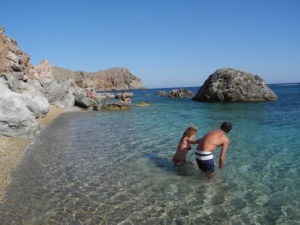
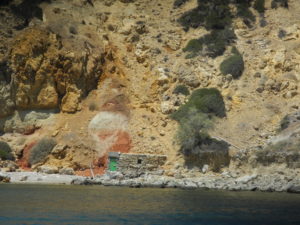
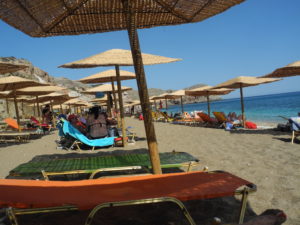
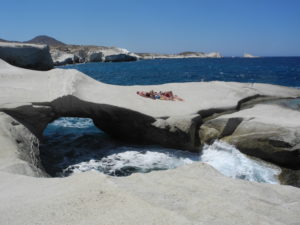
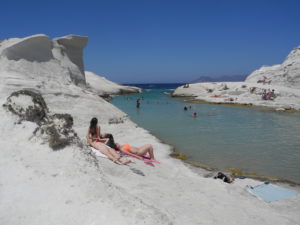
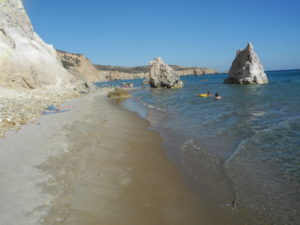











Leave a Reply